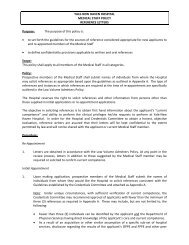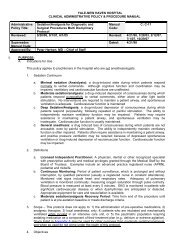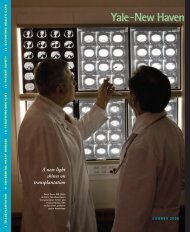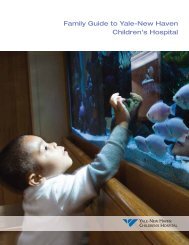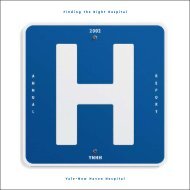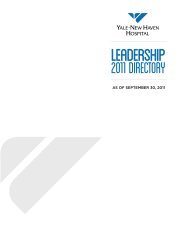Medical Staff Education Reading Materials - Yale-New Haven Hospital
Medical Staff Education Reading Materials - Yale-New Haven Hospital
Medical Staff Education Reading Materials - Yale-New Haven Hospital
Create successful ePaper yourself
Turn your PDF publications into a flip-book with our unique Google optimized e-Paper software.
A. KEY SAFETY ELEMENTS<br />
RADIATION SAFETY<br />
Most healthcare workers receive no more radiation exposure than what occurs naturally in the<br />
environment. Employees who work in restricted areas are monitored to e nsure safety (film<br />
badges). " Time", "distance", and " shielding" are key safety el ements when working a round<br />
radiation sources:<br />
Minimize the time spent in the patient's room or near the patient who is being treated with<br />
radionuclide therapy.<br />
Maintain at least 6 feet away from the patient being treated with a radioactive implant when<br />
not providing direct patient care or when x-rays are being taken.<br />
Wear appropriate shielding such as a lead apron and thyroid collar when assisting with xray<br />
procedures.<br />
B. MAIN SOURCES OF RADIATION IN A HEALTH CARE FACILITY<br />
Sources of radiation in a health care facility include x-ray machines, therapeutic radiology<br />
equipment and radionuclides. X-rays only generate radiation when making the image using a<br />
focused beam. They do not make patients or objects radioactive. In much larger doses, radiation<br />
is used to destroy tumors or other diseases. Radionuclides are radioactive materials may be<br />
implanted, swallowed, or injected. Unlike x-rays, the patient receiving radionuclide treatment does<br />
become radioactive. In most cases, diagnostic radionuclides present no significant danger to the<br />
patient and the radioactivity wears off quickly- usua lly in a day or so. In much larger does,<br />
radionuclides are used to destroy tumors or other disease. A se aled implant is a small capsule<br />
containing radioactive material that is inserted into a patient. The patient is radioactive as long as<br />
the implant is in place.<br />
C. PRECAUTIONS<br />
Take special precautions when working around radiation, r adioactive sources or near<br />
patients receiving radionuclide therapy to decrease exposure to radiation:<br />
Do not enter a p atient's room la beled with the radiation caution sign unless you need to<br />
provide direct patient care and have been trained to do so.<br />
Wear disposal gloves when handling waste.<br />
Wash hands to remove traces of radioactivity after removing gloves and do not rub your eyes<br />
or face when working around radiation.<br />
Do not remove anything from the patient's room as it may be contaminated with radioactivity.<br />
Do not eat, drink, smoke, or apply cosmetics around radioactive substances as radiation may<br />
enter the body through the eyes, nose or mouth.<br />
Dispose of contaminated material (gloves, uniforms, etc.) in appropriately marked containers.<br />
If you suspect a radiation leak, do not attempt to clean it up yourself. Always follow proper<br />
department procedures when dealing with a radiation leak. Mark off the area and notify the<br />
Radiation Safety Officer (8-2950). Further information may be fo und in the Hazardous Spill<br />
Reporting section of the Emergency Preparedness Plan found in the Safety Manual.<br />
If you work around radiati on regularly, your radiat ion exposure will be monitored to ensure<br />
your safety.<br />
Unborn babies are especially sensitive to radiation. Notify your immediate supervisor if you<br />
are pregnant and have been assigned to care for a patient undergoing radionuclide therapy.<br />
Contact the Radiation Safety Officer if you have questions concerning radiation, radioactivity,<br />
and radioactive materials.<br />
Follow department-specific procedures and pr otocols when working a round radiation and<br />
radioactivity.<br />
12


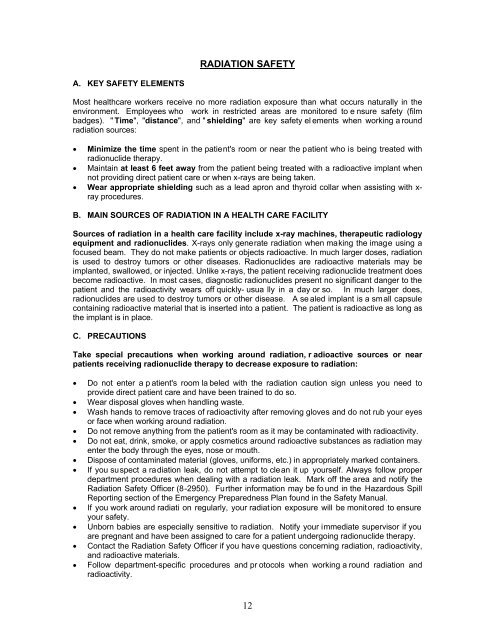
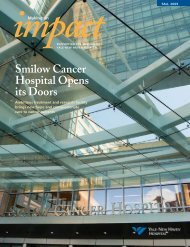
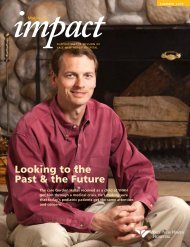

![Annual Report Donor Listings [pdf] - Yale-New Haven Hospital](https://img.yumpu.com/49673575/1/190x245/annual-report-donor-listings-pdf-yale-new-haven-hospital.jpg?quality=85)

